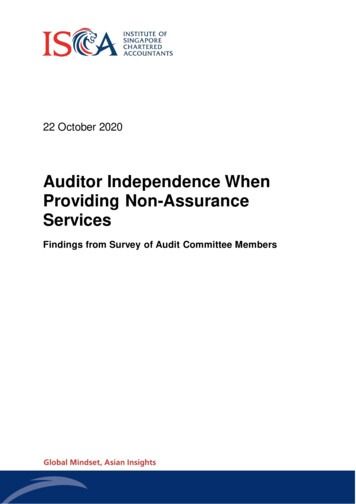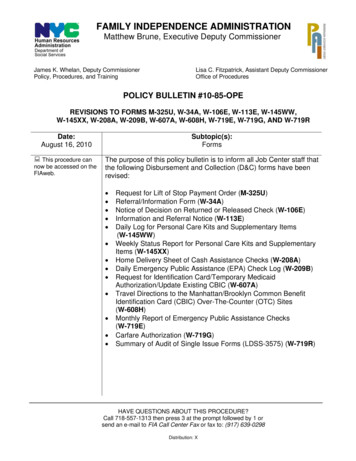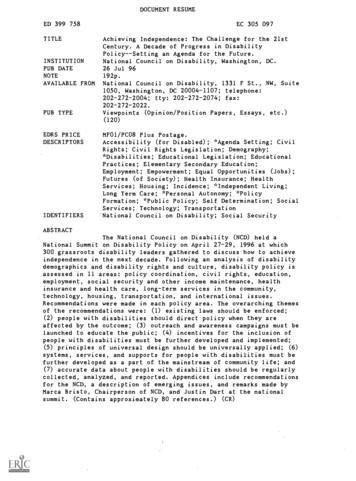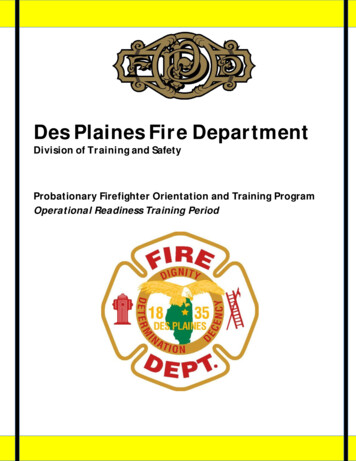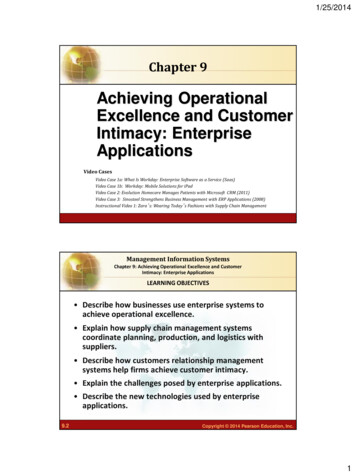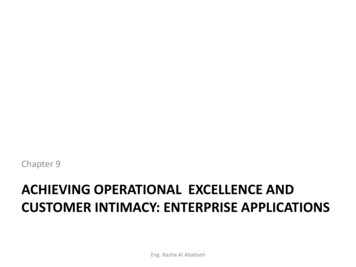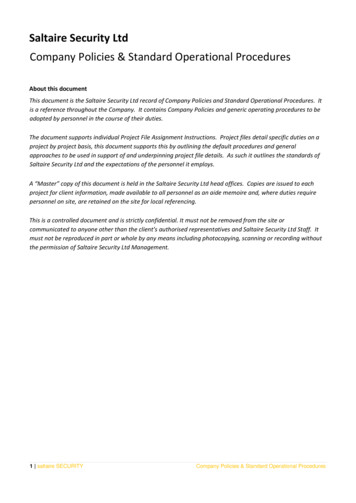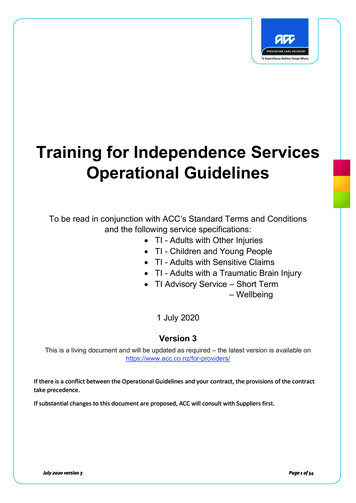
Transcription
Training for Independence ServicesOperational GuidelinesTo be read in conjunction with ACC’s Standard Terms and Conditionsand the following service specifications: TI - Adults with Other Injuries TI - Children and Young People TI - Adults with Sensitive Claims TI - Adults with a Traumatic Brain Injury TI Advisory Service – Short Term– Wellbeing1 July 2020Version 3This is a living document and will be updated as required – the latest version is available onhttps://www.acc.co.nz/for-providers/If there is a conflict between the Operational Guidelines and your contract, the provisions of the contracttake precedence.If substantial changes to this document are proposed, ACC will consult with Suppliers first.
Training for Independence Services Operational GuidelinesContents1. Definitions . 52. Training for Independence Services . 63. Purpose . 64. Service objectives . 74.1 ACC will measure the success of this Service based on the following objectives: . 74.2 TI services are flexible and use an interdisciplinary approach to achieve outcomes which increase Clients’independence. . 75. Relationships and Responsibilities . 75.2 Supplier responsibilities . 85.3 Client responsibilities . 95.4 ACC responsibilities. 105.5 Communication and relationship expectations . 115.6 Communicating as well as reporting . 116. Key worker . 116.1 The key worker is most effective in their relationship with the Client when they: . 127. Client eligibility . 127.1 All Clients . 127.2 Additional eligible criteria . 138. Special circumstances . 148.1 Example of special circumstances . 148.2 In these complex situations ACC expects the Supplier to provide: . 149. Supporting transitions from DHB or other services into TI services . 1410.Service phases . 1510.1 Process map showing the four phases . 1611.Referral . 1611.1 Training for Independence Referral form ACC2134 . 1711.2 Referral steps . 1712.Planning . 1812.1 ACC Purchase order . 18Planning Phase . 1812.2 Goal and objective setting . 20
Training for Independence Services Operational Guidelines12.3 Developing SMART goals . 2012.4 Examples of a SMART goal . 2112.5 Reviewing Goals . 2112.6 Costing the plan . 2212.7 Allocation of hours and service limits . 2212.8 Unspecified time . 2312.9 TIAS Short Term . 2412.10 TIAS Wellbeing . 2412.11 Approving the rehabilitation plan . 2413.Delivery . 2513.1 Service location. 2513.2 Home-based rehabilitation . 2513.3 Provider Travel. 2513.4. Clinic-based rehabilitation . 2513.5 Remote or distance rehabilitation - TeleRehab . 2513.6 Services delivered to all Clients . 2613.7 Services delivered to specific Clients . 2713.8 TI Advisory Service Specialisation . 2813.9Integrated Home and Community Support Service Relationship Protocol . 2813.10 Liaison / Case conferences. 2913.11 Taking a break from rehabilitation (Consolidation breaks) . 2913.12 Equipment . 29TI Advisory Service – equipment needs . 3013.14 Client reporting . 31ACC2126 – Training for Independence Report . 31TI Rehabilitation Plan . 31Variance report . 31Completion report . 3113.15 Invoicing for Report Writing . 3113.16 Client non-attendance . 32Example of invoicing for non-attendance . 32Service exit due to non-attendance . 3313.17 Completion of Programme . 3314Quality management . 3314.1 Interdisciplinary team . 3314.2 Qualifications, Membership and Experience . 3314.3 Culturally competent services . 3414.4 Timeframes for delivery of services and reporting . 3514.5 Measurement of Client progress . 36
Training for Independence Services Operational Guidelines14.6 Supplier Performance . 3614.7 Supplier Performance Measures . 36Table setting out Performance Measure Targets . 3714.Exclusions . 3715.1 Service specific exclusions. 3915Termination or suspension . 3916Working with Clients who may pose a health and safety risk . 4017.1 Communication regarding care indicated Clients. 4017.2 Stopping an assessment or services due to H&S concerns . 4017.3 Reporting health and safety risks and incidents . 4017Appendices . 41Appendix A - Guide to the ACC2134 Training for Independence Referral form . 41Appendix B – Guide to completing the ACC2126 Training for Independence Report . 43Appendix C – Code List. 45Appendix D – Guiding Principles for Pressure Injury Prevention and Management in New Zealand (the guide) . 45Appendix E – Provider Qualifications, Experience, Training and Supervision Requirements . 46TI Advisory Services . 46TI - TBI . 47TI AOI. 48TI CYP . 49TI ASC . 51Rehabilitation Coach across all TI services . 51Appendix F – Training for Independence Forms . 53Version Control - Log of Changes to this document . 54
Training for Independence Services Operational Guidelines1. DefinitionsThe following definitions apply for this operational guideline.ACC Recovery TeammemberThe term refers to the person responsible for the Client’s case at ACCand represents a number of roles depending on where the claim isbeing managed.ClientThe injured person receiving one of the individual TI services.Family / WhānauPeople related to the injured person such as a wife, husband,daughter, son, grandchild, etc. This can be whoever the Client definesas family with the appropriate responsibilities that may entitle.Interdisciplinary team The term means a group of health care professionals from diverse(IDT)fields who work in a coordinated fashion toward a common goal for theClient.As the name implies, teamwork in health care employs the practices ofcollaboration and enhanced communication to expand the traditionalroles of health workers and to make decisions as a unit that workstoward a common goal.Key workerThe key worker is a provider with specific responsibilities for anindividual Client as outlined in this operational guideline. The keyworker assumes the operational responsibility for the delivery ofservices to the assigned Client on behalf of the Supplier.ProviderService ProviderThe provider delivers the service and is face to face with the Client.They may also be a Supplier. Their professional qualifications areoutlined in the service specification and this operational guideline.SupplierThe Supplier is the legal holder of the contract and has the full andfinal responsibility for the delivery of the service. The Supplier can alsobe a service provider and the employer of service providers.TI PlanThe term means: TI Rehabilitation Plan for Training for Independence servicesTI Monitoring Plan for Training for Independence AdvisoryWellbeing ServiceAn agreed plan is not required for Training for Independence AdvisoryShort Term Service.IndividualRehabilitation Plan(IRP)This document is developed by ACC with the Client. This is separatefrom the TI Plans referred to above.
Training for Independence Services Operational Guidelines – July 2020 7UDLQLQJ IRU ,QGHSHQGHQFH 6HUYLFHV 7KH 7UDLQLQJ IRU ,QGHSHQGHQFH 7, VHUYLFHV VXSSRUW &&¶V FRPPXQLW\ UHKDELOLWDWLRQ VHUYLFHV 7KH ILYH FRQWUDFWV SURYLGH IOH[LEOH DQG LQGLYLGXDO VHUYLFHV WR PHHW WKH QHHGV RI D GLYHUVH UDQJH RI &OLHQWV 7KH 7UDLQLQJ IRU ,QGHSHQGHQFH FRQWUDFWV DUH x GYLVRU\ 6HUYLFH 6KRUW 7HUP 7, ' 67 KRXUV LQ ZHHNV :HOOEHLQJ 7, ' :% KRXUV LQ PRQWKV x GXOWV ZLWK 7UDXPDWLF %UDLQ ,QMXULHV 7,7% x GXOWV ZLWK 2WKHU ,QMXULHV 7, 2 x GXOWV ZLWK 6HQVLWLYH &ODLPV 7, 6 x &KLOGUHQ DQG RXQJ 3HRSOH 7,& 3 TI ServicesTI AdvisoryShort TermTI RehabilitationTIChildren &Young PeopleTI AdvisoryWellbeingTI AdultsWith TBITI Adults withSensitive ClaimsTI Adults withOther Injuries 3XUSRVH 7KH SXUSRVH RI WKH 7, VHUYLFHV LV WR x UHVWRUH DQG RU PDLQWDLQ WKH &OLHQW¶V LQGHSHQGHQFH DQG DELOLW\ WR SDUWLFLSDWH LQ WKHLU HYHU\GD\ DFWLYLWLHV DQG ZLWKLQ WKHLU ZLGHU FRPPXQLW\ WR WKH PD[LPXP H[WHQW SUDFWLFDEOH DQG x UHGXFH WKH &OLHQW¶V OLNHO\ QHHG IRU IXUWKHU UHKDELOLWDWLRQ
Training for Independence Services Operational Guidelines – July 20204. Service objectives4.1 ACC will measure the success of this Service based on the following objectives: Clients gain functional ability, education, skills and knowledge that increase the Client’sindependence, resilience and participation in their everyday livesClients can independently manage their usual day to day activitiesClients have a reduced need for further rehabilitation and other ACC funded ServicesClients have a reduced incidence of further injuriesClients will not have preventable injuries or deterioration such as pressure injuries asoutlined in appendix D or other secondary injury caused by preventable means and/ordeterioration of their covered injuryClients receive timely rehabilitation services.4.2 TI services are flexible and use an interdisciplinary approach to achieve outcomeswhich increase Clients’ independence.Flexible servicesEach person who sustains an injury has an individual recovery path, thereforerehabilitation needs can vary. ACC and Suppliers will adapt services to get the bestrehabilitation outcomes for the Client. Services are delivered in the Client’s environmentas appropriate to meet the Client’s rehabilitation goals.Interdisciplinary team approachTI services are provided by a highly experienced interdisciplinary team (IDT)specialising in providing rehabilitation services. Team members are selected
ACC Recovery Team member The term refers to the person responsible for the Client’s case at ACC and represents a number of roles depending on where the claim is being managed. Client The injured person receiving one of the
